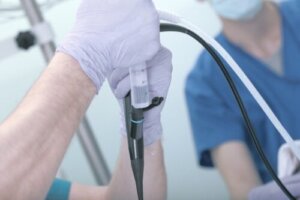What Is Cystoscopy? Risks and Benefits

Cystoscopy is a very frequently used procedure in urology. It allows both diagnosis and treatment of certain pathologies affecting the bladder and urethra. It consists of inserting a tube through the urethra, which has a small camera at the tip.
Thanks to this tool, the inside of the bladder can be observed. In addition, other instruments can be introduced to perform tissue biopsies or to remove something that’s causing an obstruction.
The problem is that, like many other similar procedures, it isn’t risk-free. Today we’re going to explain everything you need to know about this procedure, why it’s performed, and what its possible complications are.
What does a cystoscopy consist of?
Cystoscopy is one of the procedures most commonly used by urologists for the diagnosis and treatment of certain diseases affecting the bladder and urethra.
It consists of the introduction of a small-caliber tube through the urethra into the bladder. This, in turn, carries a small camera at the tip that allows direct visualization of the walls of the urethra, bladder, prostate, and ureteral orifices.
According to Mayo Clinic specialists, it’s one of the most useful techniques for diagnosing bladder diseases. For example, it can help diagnose cancer, cystitis, or the presence of stones. It also helps determine the cause of frequent urinary tract infections.
In men, it can even point to prostate hyperplasia. This is a situation in which the prostate increases its size considerably. This causes it to put pressure on the urethra and narrow, so that the cystoscope can’t pass through it.
In addition, the procedure can be used to treat numerous pathologies, since other tools can be introduced through the tube. For example, forceps can be used to remove a small tumor or to help take a small tissue sample for a biopsy.
Types of cystoscopy tubes
Cystoscopy is performed by inserting a tube about 40 centimeters (16 inches) long and about half a centimeter in diameter. This tube is called a ‘cystoscope’. Originally, it was a much simpler hollow tube.
However, thanks to advances in science, it now has many more tools and utilities. There are two main varieties: a flexible one and a rigid one.
- The flexible cystoscope causes less discomfort to the patient. In addition, it allows a faster analysis of the bladder.
- The rigid tube, although more uncomfortable, allows clearer images of the inside of the bladder to be obtained.
However, the flexible tube doesn’t allow the introduction of other tools. Therefore, if you want to treat or perform more complex measures during cystoscopy, it’s recommended to use the rigid tube.
How is this test performed?
To perform a cystoscopy, the physician first needs to have performed a physical examination of the patient. This test can be performed in the consultation room or in the operating room. The choice of location depends mainly on whether general anesthesia is used or not.
The patient will be lying on his or her back with legs spread and knees bent. If a flexible cystoscope is used, it’s possible to stretch the legs. Often, instead of general anesthesia, a lighter sedation or local anesthesia is used.
Once the cystoscope is in place, saline is passed through the cystoscope to fill the bladder. This is usually a short test, between 15 and 60 minutes. In any case, the time may vary depending on what is needed to be carried out during the procedure. If a rigid cystoscope is used, it usually takes longer.
Possible risks
Cystoscopy is an invasive test, as it involves introducing a foreign body into the body. Because of this, a number of complications can occur. One of the most common is pain or discomfort after the procedure.
Similarly, there may be slight bleeding or a burning sensation when urinating. Although less frequent, it can cause a urinary tract infection, especially if the patient has any risk factors, such as other comorbidities or old age.
For this reason, it’s essential to contact a physician if they get a fever or if the pain lasts for more than two days. The same applies if heavy bleeding occurs or if you’re unable to urinate after the technique.
How to prepare for cystoscopy
Cystoscopy is a relatively simple procedure. However, it requires a number of aspects and considerations to be taken into account before it’s performed. The following sections explain the basics.
Before the procedure
Before going for a cystoscopy, the doctor may modify or add certain treatments for the patient. For example, it may be necessary to take antibiotics beforehand. This reduces the risk of infection with the test.
It’s often recommended to stop taking anticoagulant drugs in the days prior to the test. On the other hand, it’s suggested to come to the consultation with a full bladder. This is because it may be necessary to take urine samples for laboratory analysis.
During the test
The procedure is sometimes performed under anesthesia or sedation, although in some cases only local anesthetics are used. If so, you’ll be conscious during the test and may feel the cystoscope being inserted.
However, because local anesthetics are used, the area will be numb. Throughout the examination, both the inside of the urethra and the bladder are observed. The bladder is filled with saline to better visualize the inside of the bladder. The doctor sees the images projected on a screen, live.
What to expect after cystoscopy
After the test, the patient must remain in a recovery area for at least one, and possibly several, hours, especially if sedation or general anesthesia has been used. It’s essential to wait for the effects of the anesthesia to wear off.
In addition, since saline is introduced into the bladder, it’s usually recommended to urinate immediately after the procedure. In this way, it’s observed if any discomfort or complication appears.
After this, it’s recommended to drink water and take painkillers to alleviate possible ailments. Warm, moist cloths over the urethra are also recommended to mitigate inflammation and pain.
What can the results indicate?
Cystoscopy can provide guidance on the appearance of various pathologies. For example, polyps, areas of stricture, malformations, or atypical lesions can be observed during the process. The simple observation of some of these can be diagnostic of a disease.
Moreover, as biopsies can be obtained with this technique, it can be used to analyze whether or not it’s a tumorous process. In these cases, the results are slightly delayed; just enough time for the laboratory to analyze the samples.
Cystoscopy is a very useful procedure
The great advantage of cystoscopy is that in addition to diagnosis, it can be used to instantly treat certain pathologies. In addition, it’s a fairly safe procedure, with a low risk of complications.
All cited sources were thoroughly reviewed by our team to ensure their quality, reliability, currency, and validity. The bibliography of this article was considered reliable and of academic or scientific accuracy.
-
Abu Nasra, W., Abu Ahmed, M., Visoky, A., Huckim, M., Elias, I., & Katz, R. (2020). The Importance of Cystoscopy in Diagnosis and Treatment of Urethral Stricture Following Transurethral Prostatectomy. The Israel Medical Association journal : IMAJ, 22(4), 241–243. https://pubmed.ncbi.nlm.nih.gov/32286028/
- Cistoscopia – Mayo Clinic. (2022, 17 diciembre). https://www.mayoclinic.org/es-es/tests-procedures/cystoscopy/about/pac-20393694
- Engelsgjerd, J. S., & Deibert, C. M. (2022). Cystoscopy. In StatPearls. StatPearls Publishing. https://www.ncbi.nlm.nih.gov/books/NBK493180/
-
Gee, J. R., Waterman, B. J., Jarrard, D. F., Hedican, S. P., Bruskewitz, R. C., & Nakada, S. Y. (2009). Flexible and rigid cystoscopy in women. JSLS : Journal of the Society of Laparoendoscopic Surgeons, 13(2), 135–138. https://www.ncbi.nlm.nih.gov/pmc/articles/PMC3015938/
- Información sobre su cistoscopia en el quirófano | Memorial Sloan Kettering Cancer Center. (n.d.). Retrieved March 23, 2021, from https://www.mskcc.org/es/cancer-care/patient-education/about-your-cystoscopy.
-
Safiullah, S., Lama, D. J., Patel, R., & Clayman, R. V. (2018). Procedural Module: Flexible Cystoscopy. Journal of endourology, 32(S1), S2–S6. https://pubmed.ncbi.nlm.nih.gov/29774810/
This text is provided for informational purposes only and does not replace consultation with a professional. If in doubt, consult your specialist.









